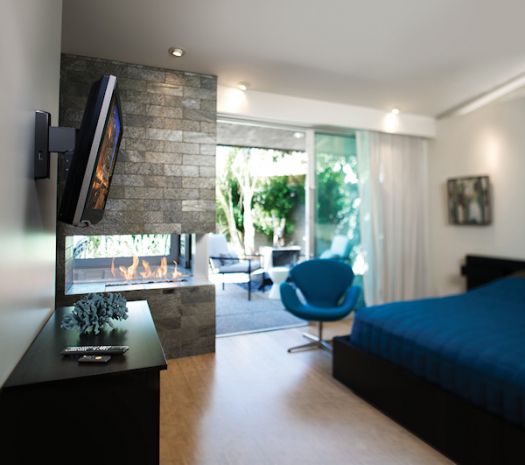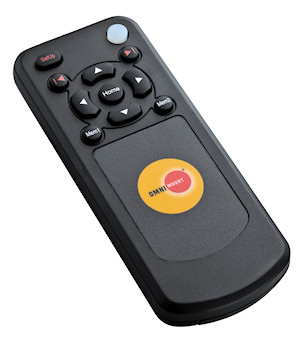Sermon on the Mount
My wife is, to put it politely, entirely unimpressed with the toys I get to play with for work. Every new remote control garners an "Eh" at best. Snazzy new surround processor? "Meh." New speakers? "Feh!" The last product I reviewed that earned much more than a monosyllabic dismissal was the Kaleidescape multi-room music and media distribution system. That system may have actually elicited a response along the lines of, "pretty cool."
So I find it a bit perplexing (and more than a bit entertaining) that she won't shut up about the OmniMount Power40 flat panel TV mount I recently installed in the bedroom. She's telling all her friends about it. She's dragging guests into our bedroom to look at it. And I can't help but chuckle at the fact that mounting a flat panel TV on the wall is still such a novelty, but there you have it -- irony truly is dead.
To be fair, the Power40 is more than a simple wall mount, though. While mounting solutions have become more affordable than ever as of late, especially since the introduction of OmniMount's own uncapitalized, eponymous $40 mounting system, "the omnimount," the Power40 is definitely at the other end of that spectrum, costing more than some of the displays it's capable of holding (it's designed to accommodate most 23- to 46-inch flat panels, up to 66 pounds).
As its name implies, the Power40 Remote Controlled Motorized Cantilever Mount not only hangs your plasma or LCD on the wall like a pretty picture, it also adds a panoramic element to the mix, allowing you to tilt and swivel your TV without ever leaving the comfort of your easy chair (or bed, as it were).
Despite being a quite sophisticated mount, though, the Power40 is rather ridiculously easy to install, even without an extra set of front paws. All you need is a power drill, screwdriver, stud finder, pencil, and about an hour of free time; everything else is in the box -- including the proper drill bit and even a little handheld bubble level.
Also included in a box is a handy wall template, which you stick to the wall with double-sided tape once you've located your stud. It's amazing how helpful a bit of cardboard can be; the template not only comes with a fold-down lip for easy leveling, it also shows you exactly where the mounting plate that screws onto the back of your TV will be located once the mount is in place (which in turn lets you figure out exactly where the top of your TV will be when all is said and mounted). There's also a little pocket at the bottom for catching dust and sheetrock when you drill the pilot holes for the wall assembly. Sometimes it's the little things...
Another seemingly small but amazingly helpful feature is the fact that the wall assembly separates into two pieces, with a smaller, easier-to-manage bottom bracket that bolts in place first (ideally into a stud, but the mount also works with masonry walls) and supports the weight of the bulkier upper assembly, while also keeping it level. Without this, there's no way installing the Power40 would be a one-Wookiee job.
After both pieces of the wall assembly are in place, it's a simple matter of lining up the tongue and groove on the back of the TV mounting plate and the mount arm, dropping the TV into place, and putting in a couple of locking screws from underneath. I found this much easier to manage with the arm fully extended, so if you install a Power40 yourself you might want to connect the power cord and IR repeater cable before you mount the TV. But if you've got an extra set of eyes to line you up from the side, that might not be necessary.

Of course, the big question is: why would you need a motorized cantilever mount to begin with? Honestly, I figured after some of the novelty wore off, I would set the mount where I wanted it and lose the remote. But the newness has worn off (for me, anyway; the missus is still in the honeymoon phase with this thing), and I find myself tilting and panning far more than I would have imagined. Even though my Samsung LN40A550 LCD is nearing the upper size and weight handling capacity for the Power40, operation is surprisingly quiet and silky smooth, except for a slight bit of minor wobbling as it settles back into its home position.
Granted, the motorized arm only extends away from the wall about seven inches at its maximum reach, limiting left-and-right swivel to about 20 degrees (maximum up-and-down tilt is more like 15 degrees), so don't expect the Power40 to have the same 180-degree freedom as some of OmniMount's manual cantilever mounts. But still, that's plenty to make TV watching easier when I'm putting clothes away in the closet or bureau on the left side of the bedroom.
And the tilt is more than enough to make TV watching easy from bed without having to sit up. But even when sitting up, I've found the remote tilt a handy function more than a few times: if the missus is reading and her lamp is reflecting on the corner of the screen, a quick button press and the ensuing scooch to the left nips that glare in the bud. In fact, if I were the type to label things, "Scooched slightly to the left and tilted down so I can watch TV without all the glare when the missus is reading in bed" would be the label attached to one of my two preset positions.

My only real complaint with the Power40 at all is the lack of integrated cable management. OmniMount did send one of their Cable Management Kits to hide the wires running from my gear to the TV and the power cord for the mount itself (and it works beautifully, I might add), but with no way to secure the cables to the mount itself, sometimes the cables get snagged as they're being pulled along for the ride, and the mount won't swivel to its fullest extent because it thinks it's bumping into a wall.
Turn-Ons:
Turn-Offs
Final Thoughts:
If you're looking for a cheap wall mount solution for your LCD or plasma display, this isn't it. As I said, the Power40 sells for more than some TVs at the smaller end of the range it's designed to hold. If you view a mount as little more than an accessory for your TV (and an unseen one, at that), that's probably going to be a significant concern.
But there's no doubt that the Power40 has changed the way I use the TV in my bedroom, which elevates it well above mere unseen accessory status.
And it's made my wife absolutely giddy. I'd call that a bargain.
Specifications from the Manufacturer:
Manufacturer's Contact Information:
OmniMount
8201 South 48th Street
Phoenix, AZ 85044
1-800-MOUNT-IT (800-668-6848)
On the Web: www.OmniMount.com
Where to Buy:
| Overall | |
|---|---|
| Value | |
| Performance | |
| Features/Ergonomics |